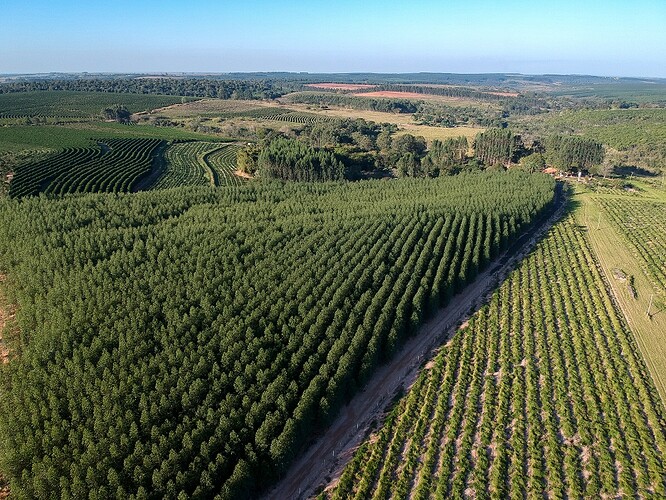Sawmills and traders across South America are seeing an exponential increase in inquiries out of Europe for FSC and PEFC South American lumber and hardwood plywood. The sudden shock in the European wood product value chain has created a real and palpable fear of massive shortages due to the ban on wood products imports from Russia, Belarus, and the Ukraine. This will put further upward price pressure and increased competition for US importers and distributors of South American lumber and panel products.
@David_Stallcop Thank you for posting. It’s fascinating to track how the lumber cards are re-shuffling. Are you hearing anything from Canadian Mills and Traders about European inquiries? Do you think there are potentially new trade flows from Canada into Europe?
Andrew, the only inquiries that I am seeing for Europe and the UK out of Canada is for clear flat grain and vertical grain hemlock, doug fir and cedar which are already in short supply to replace the high grade Siberian Larch that was heavily used in siding and decking applications. My gut tells me that thermally treated European pine and spruce as well as US Southern Yellow Pine shipped to Europe to thermally treat is the direction that the building materials industry in Europe will go to replace the lost volume of Siberian Larch. Most of the thermal treatment plants in Europe are already at capacity so they will need to expand their number of thermal treatment tubes to make up for the excess demand. There will be an increased demand for WPC decking in Europe as well.
Thermal Treatment? like Kiln Dried and Heat Treated? I am unfamiliar with how thermal treatment requirements differ between countries and what the requirement for international trade would be here.
Thermally modified wood is a natural, non-toxic alternative to chemically treated wood products for the home. Unlike pressure-treated lumber, thermally modified wood undergoes a thermal modification process. The wood is essentially “cooked” in oxygen-free ovens at temperatures over 400 degrees Fahrenheit. You are dropping the moisture content down to below 5%. A lot of clear Ash is thermally treated in both Canada and in Europe. Clear VG Hemlock that is Thermally treated looks exactly like old growth Western Red Cedar. It’s also really popular in both New Zealand and Australia where the PNW used to export a lot of WRC back in the 80’s and 90’s.
In other words, thermally modified is synonymous to kiln drying to a lower moisture content for softwood lumber. Hardwoods are already kiln dried to a 6-8% moisture content and yet they still are susceptible to rot and decomposition as most, other than the white oak species, will retain some of that cell moisture back through ambient humidity.
I would just recommend a complete industry change to the future including products like magnesium oxide panels that are unaffected by moisture, fire, termites, mold and decomposition and are completely recyclable and can be made to look just like wood products.
Jeff, with Thermal treatment the lumber is literally cooked in a oxygen free vacuum tube. It is a completely different drying process compared with traditional hardwood or softwood dry kiln technologies.
87% of the worlds Magnesium Oxide production comes from China.
As we are seeing with the worlds reliance on Russian oil, gas and timber, I would much prefer to keep the full control of the entire production process here in the US for our own domestic market.
Thermal treatment is definitely the future globally for both exterior wood siding and decking…
Your facts are incorrect as it used to be the case where MgO production largely came from China as they invented this process of MgO board production, but is now expanding to Turkey, India (where large deposits are) and even our plants in the US where MgO powder is now sourced in Canada while US deposits of magnesite are too expensive, as the MgO is too pure in the manufacturing process for board production where there would be enough to supply hundreds of years of MgO board production.
As for thermal treatment, the results are costly, with shortcomings of reduced tensile strength, bending characteristics, unstable color results (especially in hardwoods), and appearance of surface cracking (also a bad outcome for hardwood lumber). It has been established that the resistance of heat-treated wood against weathering (UV light and moisture changes) is not changed largely when compared to untreated wood, making a surface treatment with coatings necessary. So cost does not equal benefit for thermal treatment. These vacuum kilns have been around for a long time to prevent checking and honeycombing in wood products but were far too expensive to meet market needs and very seldom worked. Seen it, done it.
The cost will be prohibitive for a minor gain in its longevity.
There is definitely a huge need for domestic production of MgO panels in the US and Canada and the industry is excited to have it, for sure. There are so many industrial and construction applications that it can be used for domestically. In my last meeting with Nevra in Turkey, they are still reliant on 100% of their raw material coming from China and they are the largest MgO panel producer in that country.
The world is definitely seeing a major boom in demand for thermally treated pine and spruce lumber as a chemical free alternative to old growth western red cedar, douglas fir and hemlock. Even Arauco in Chile is only a few months away from full production of thermally treated radiata pine for exterior siding and outdoor furniture production. Many countries are also seeing thermally treated pine and spruce as a perfect lamella for exterior use glulam beam and cross laminated timber production.
Nevra must be a relatively new operation without access to Turkish or Indian MgO powder as most are in the region because all that we know do have their own powder source locally. All these companies overseas and I suppose in the US say they are the largest, which most who say that are not.
Again, all thermal drying does is to attempt to close off the xylem and tylosis of the wood fiber to attempt to prevent the re-humidification, and decay, of the wood via ambient humidity and/or natural precipitation and exposure to moisture. Species like white oak have a natural tendency to do that itself once kiln dried preventing humidification by cutting off avenues for moisture to reform in the wood fibers, as well as fungi, etc., however softwoods are extremely hard to mimic this natural process due to its nature and size of its xylem and tylosis processes in coniferous trees, unless they are of species like redwood and cedar that have natural defenses against such decay causing avenues. Both cedar and redwood have lost much of their natural defenses due to the lack of older growth trees left to harvest and loss of that defense. They would still need a chemical additive to prevent further weatherization and to prolong their effectiveness to resist decay. Vacuum kiln operations had always been, and still is today, a highly cost inefficient system to compete in markets except for high-priced niche markets. That could change but highly unlikely considering projections of generated power price increases in the future.
Although, properly formulated MgO is immune to moisture, it is highly recommended when exposed to the elements is to paint it to prevent saturation over time, albeit this moisture saturation would not affect its structural capabilities. MagRock+ (Plus) sheathing will have an exterior Tyvek style wrap to prevent exterior moisture from absorbing into the board over time and our siding will be protected from the elements via a normal paint job once installed and is in development to institute that barrier during its manufacture so no painting is required if it is wished.
How about WPC? Thank you guys for sharing your knowledge!
Bernard,
For sure WPC decking is a fantastic option for the industry. There are also so many new colors and designs out there where you can really get creative with any deck project.
I highly recommend that you follow Sean on LinkedIn
Going back to the original topic, it should be known for US buyers that a large proportion of wood coming from South America is illegally cut and violates US law. I believe Andrew @Pakira sent out an article showing 90% of all exports from Peru were from illegal black-market sources. Under federal law, both the importer and the buyer are liable for civil and/or criminal charges, i.e., the US Lacey Act and/or violations of US trade laws and falsifying government documents via the US Customs and Border Protection. It is not worth the effort if you are not 100% sure where the origin of this timber is from. These are felony charges and not just a slap on the wrist.
Lucky for us, Pakira happens to have another world experts on Lacey Act and EU Timber Regulation compliance in @Darren_Thomas. Darren specializes in due diligence solutions for the timber sector, conducting upstream supply chain risk assessments on behalf of US and EU buyers, with local staff on the ground in most producer countries across Asia, Africa, Latin America, as well as Russia.
Further, if anyone wants 100% certainty on the origin of your timber, then @Darren_Thomas is your guy and his “Double Helix” technology can give you just that.
@Darren_Thomas Do you see any risk of a massive shortages for FSC and PEFC wood? What are you hearing out there?
Hi Jeff, thank you for sharing your wealth of knowledge, I sell mostly Indonesian plywood sources from plantation log, as you know most factory in Indonesia is not FSC and PEFC but plantation log is legal. Do you have any insight on the Plantation log?
Thanks David, I just started learning about WPC and its usage. Hope to learn more from you!
I assume meranti plywood from either Indonesia or Malaysian sources. This product has a short shelf life for future markets, due to the over deforestation of those Indonesian forests by its largest consumer, the US recreational vehicle industry, paying no heed to the damage they have done to that resource. Just make sure you know who you are buying from is giving you the right information and that they are from plantation sources.
No, not meranti, but falcata. Meranti is in short supply now. I am selling mainly falcata now. It’s a lightweight wood of 380-400kg/m3. it is a non-structural plywood for interior furnishing construction.

